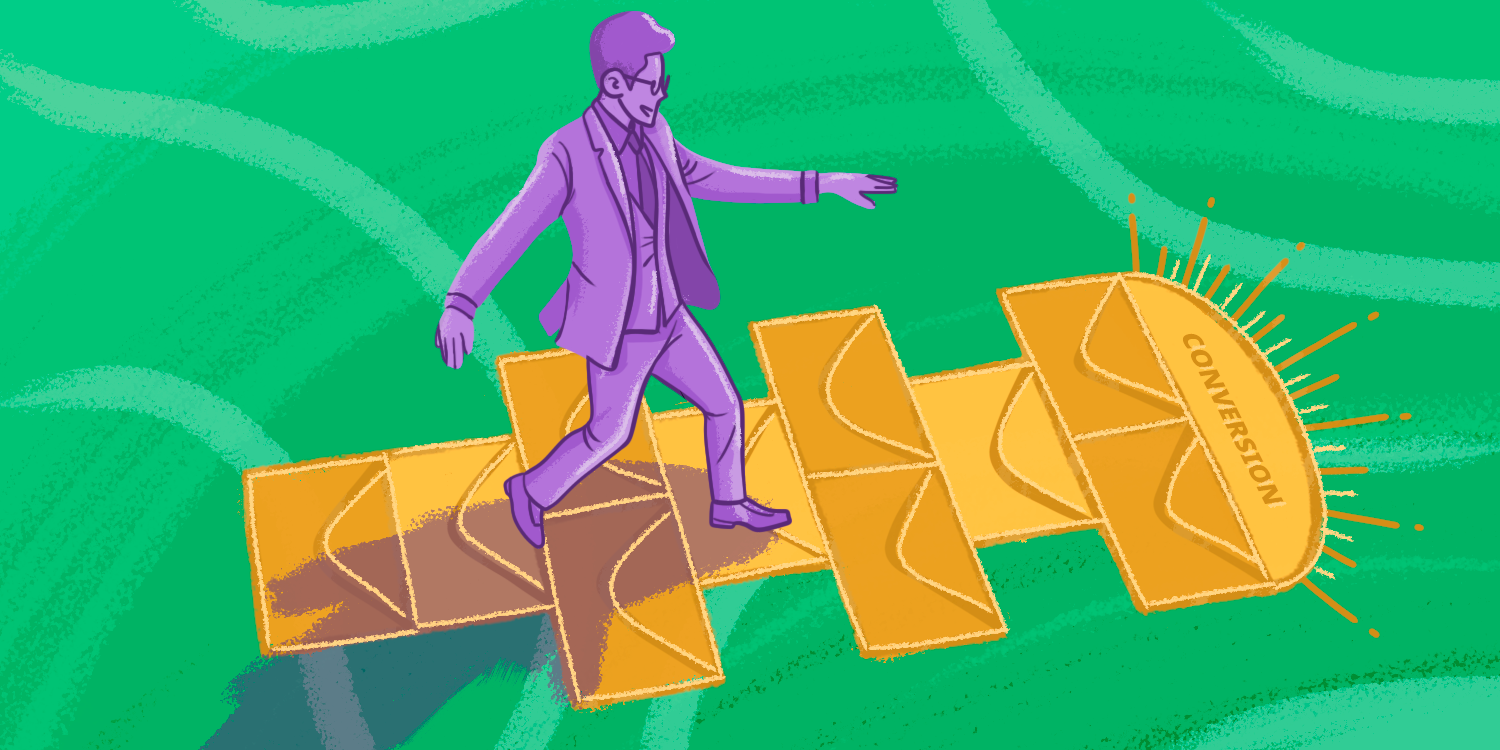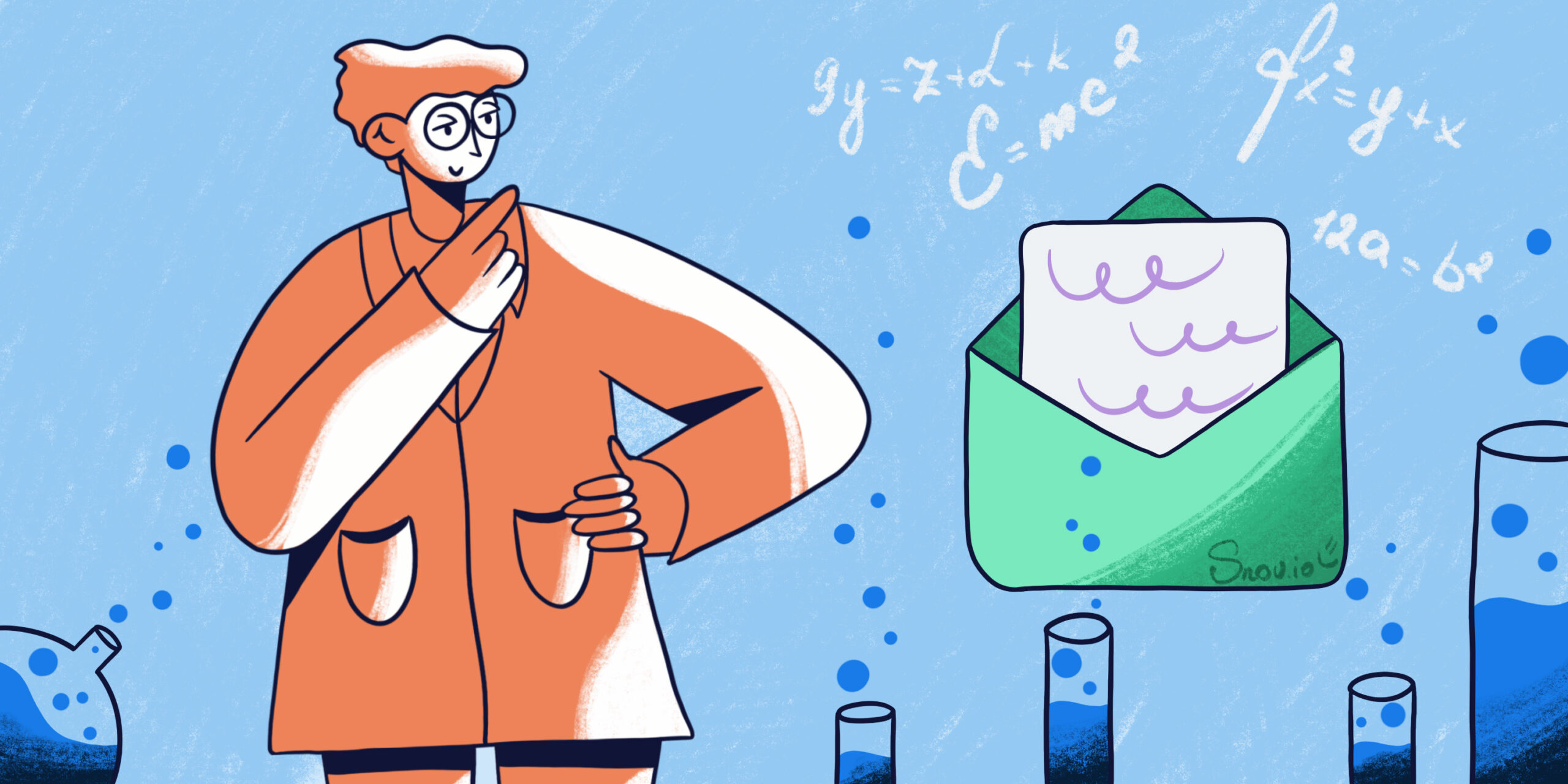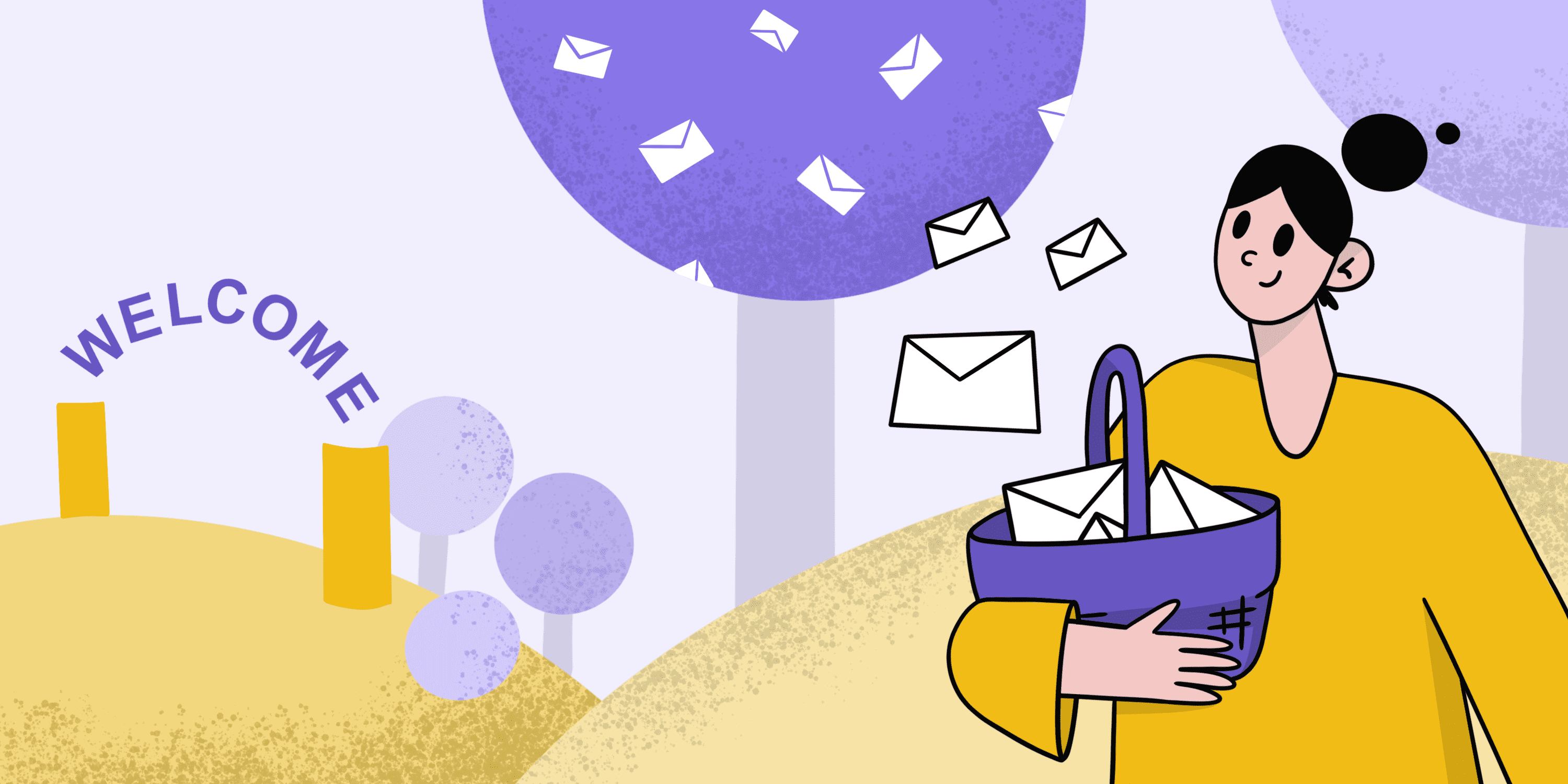When dealing with email marketing automation, you’ve most likely come across the term ‘email drip campaign’ more than once. Some sources, however, highlight another term, ‘email sequence,’ never throwing a word about email drip campaigns at all.
If this has left you puzzled, just like me, this post is for you. In this article, I’ll explain the difference between these two notions, focusing more on email sequences, how to build them, their various types, and some illustrative examples.
Off we go!
What is an email sequence?
An email sequence is a series of pre-written emails sent automatically in a specific order and at scheduled intervals to a select audience.
As a rule, email sequences are used for lead nurturing, onboarding new users, promoting products, or delivering a course of information. The aim of sending automated email sequences is to seamlessly guide recipients through the sales funnel right to a conversion (commonly a purchase decision).
Difference between email drip campaign and email sequence
The terms ‘email drip campaign’ and ‘email sequence’ are often used interchangeably, as both involve sending a series of emails to a target audience with the goal of increasing engagement rates and moving prospects closer to conversion.
Yet, there are subtle differences between the two: The term ‘drip campaign’ is broader and focuses on various automated email strategies, including email sequences.
Some email marketing experts also draw the line between the notions based on their main purpose. Email sequences are commonly used for more personalized and targeted communication, adapting to user interactions, while email drips are static emails that rely more on predetermined rules than on the user’s interactions. While personalized email sequences require thorough segmentation, for email drips, you just need to set up trigger actions and write emails.
|
To crystallize the concepts, let’s visualize examples. Situation 1 Let’s take a welcome email you automatically send using your marketing automation tool after gaining new subscribers through the opt-in form on your landing page. This email is part of an email drip campaign because it doesn’t require audience segmentation. You just program the campaign so that every new user receives the same message based on a predetermined rule: signing up for your newsletter by entering their email address. But if your campaign involves a series of welcome emails, you could say you have a welcome email sequence within your email drip campaign. Situation 2 Now, imagine a lead nurturing campaign that depends on how your leads interact with your brand at the moment. You can’t send the same email to every lead, as they are at different stages of a funnel. For instance, some may be active readers of your blog, so you’ll send them regular emails with blog digests, while others might need just a slight push to make a purchase – a perfect opportunity to surprise them with a special offer email. What you need to do in this scenario is to segment your leads and send them highly personalized emails. These emails will make up your lead nurturing email sequence. |
As you can see, the distinction between these two concepts is somewhat theoretical. For us, the senders, it’s more important to understand which email sequences are effective and how to create an automated email sequence that magnetizes prospects to convert, just like the smell of morning coffee in a popular TV ad. 🙂
That’s what we’ll talk about in the following chapters.
Email sequence examples and types
Email marketing experts won’t stop telling you about the following types of email marketing sequences:
- Welcome email sequence
- Onboarding email sequence
- Abandon cart email sequence
- Re-engagement email sequence
- Educational email sequence
- Event email sequence
- Repeat customer/post-purchase email sequence
As these types of email sequences in many aspects coincide with the respective email drip campaign types, which I’ve already talked about in one of my previous articles, I won’t stop at them here. Find their description with step-by-step instructions and email templates in my post.
In this article, I’ll cover those types which have not been previously mentioned but which are very common:
- Lead nurturing email sequence
- Engagement email sequence
- Follow-up email sequence
- Conversion email sequence
- Improved sales email sequence
- Reminder email sequence
Lead nurturing email sequence
Of course, you can create a lead nurturing email drip campaign that will include various email sequences (welcome, educational, event, you name it). But in this paragraph, I’ll talk about a lead nurturing email sequence for companies with fast-paced sales cycles. Its goal? To give your prospects a warm welcome and swiftly move them closer to conversion.
Imagine kicking your lead nurturing sequence off with a welcome email that does more than just say “Hi.” Thank your leads for subscription and give them a lead magnet they can’t resist, coupled with first-hand instructions on how to use your service.
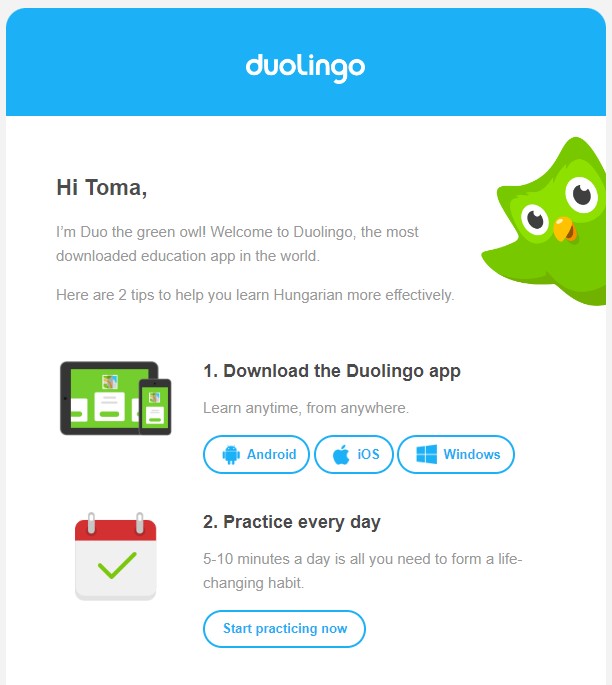
As your leads are not sales-ready yet, you should focus your lead nurturing sequence on moving them to the purchase decision. You can achieve this by highlighting the value of your product or service, adding social proof, and clearing any doubts, what not.
Let’s consider the email within a lead nurturing sequence that highlights the social proof:

Engagement email sequence
At the heart of every memorable email campaign is the art of engagement—this isn’t just about sending emails; it’s about sparking a conversation and kindling a relationship. With such an email sequence, you understand how your recipients engage with your emails and which email sequences to send them further.
|
What does building rapport mean? In sales and marketing, building rapport means creating a sense of trust and confidence that makes prospects more eager to share their needs and pain points. You can find more information about building rapport here. |
The purpose of the engagement email sequence is not to convert but rather to play the long game, aiming to pique interest and stir curiosity. If your company can boast frequent industry events or insightful content, don’t hesitate to try this email sequence for your campaigns.
The engagement sequence can also start with a welcoming email, where you thank the recipient for the subscription:

|
Important: In that first message, do more than say thanks. Ask your leads to set their preferences so you can segment them further and send content that would be relevant and most effective for your lead-nurturing email sequence. |
Following that, you start sending emails that promise useful content/events based on the chosen preferences. And then? You observe. You learn from their interactions, fine-tuning your approach with every click and open.

When an engagement email sequence is wielded with skill, it seamlessly transitions your prospects to the next act—the one where your product or service takes center stage.
Conversion email sequence
The conversion email sequence is a must-have instrument in the marketer’s toolkit, especially loved by SaaS companies for its laser-focused objective: to encourage prospects to take a certain action – be it scheduling a meeting, booking a demo, or starting a free trial.
Very often, conversion email sequences start with a series of educational emails, whereby you are sending users an email/several emails with useful information:
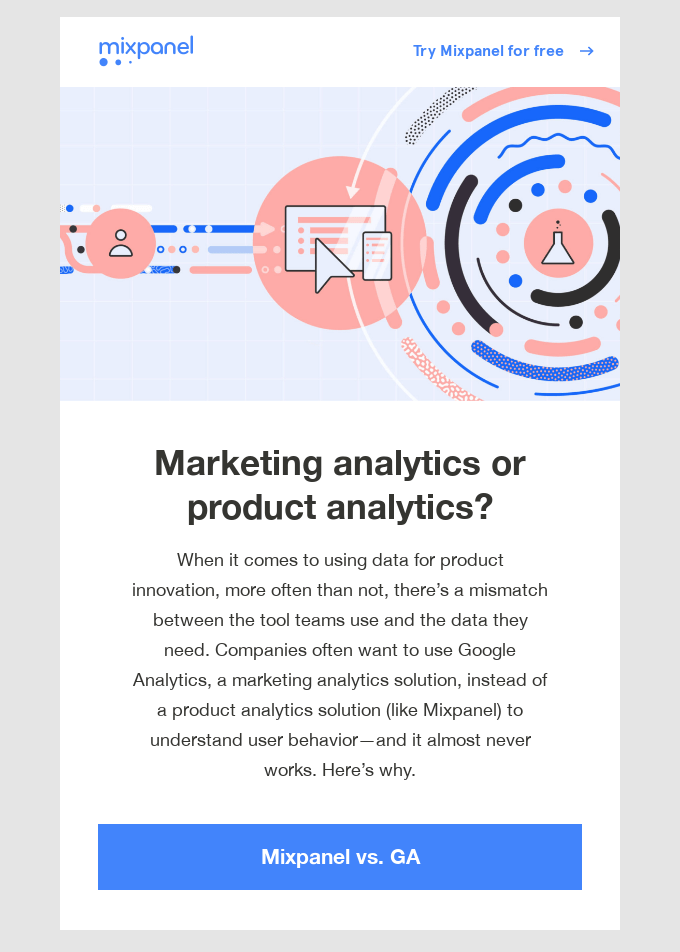
As the sequence progresses and you sense a ripening in the prospect’s journey, you encourage them to act, such as join a user session like in the example below:
 If prospects stay cold to your conversion email sequence, you can proceed with a follow-up email sequence.
If prospects stay cold to your conversion email sequence, you can proceed with a follow-up email sequence.
Follow-up email sequence
Following up is probably the key rule of a successful sales team. So, for those of you who focus on sales email outreach, email follow-up sales sequencing is a total must.
A follow-up email sequence is a set of emails you program your automation software to send either after a cold email or after a conversion email sequence in case a prospect has been silent.
|
How many emails should a follow-up email sequence comprise? The ideal number depends on several factors: the nature of your product or service, the preferences of your target audience, and the context. Remember to balance persistence with respect for the prospect’s time and preferences. Typically, a series of 3-5 well-timed and thoughtful follow-up emails would be appropriate. |
The ultimate aim of your follow-up sequence is to gently coax the reader into action. Whether securing a slot on your sales call calendar or engaging with a product demo, each email should be a persuasive and personalized call to action.

And if you’ve ever heard the statement. ‘Personalization is king!’ be sure it pertains exactly to the follow-up email sequences. The specificity with which you address the recipient’s needs and the personal touch you weave into your message—these are the threads that can bind a prospect to your brand.
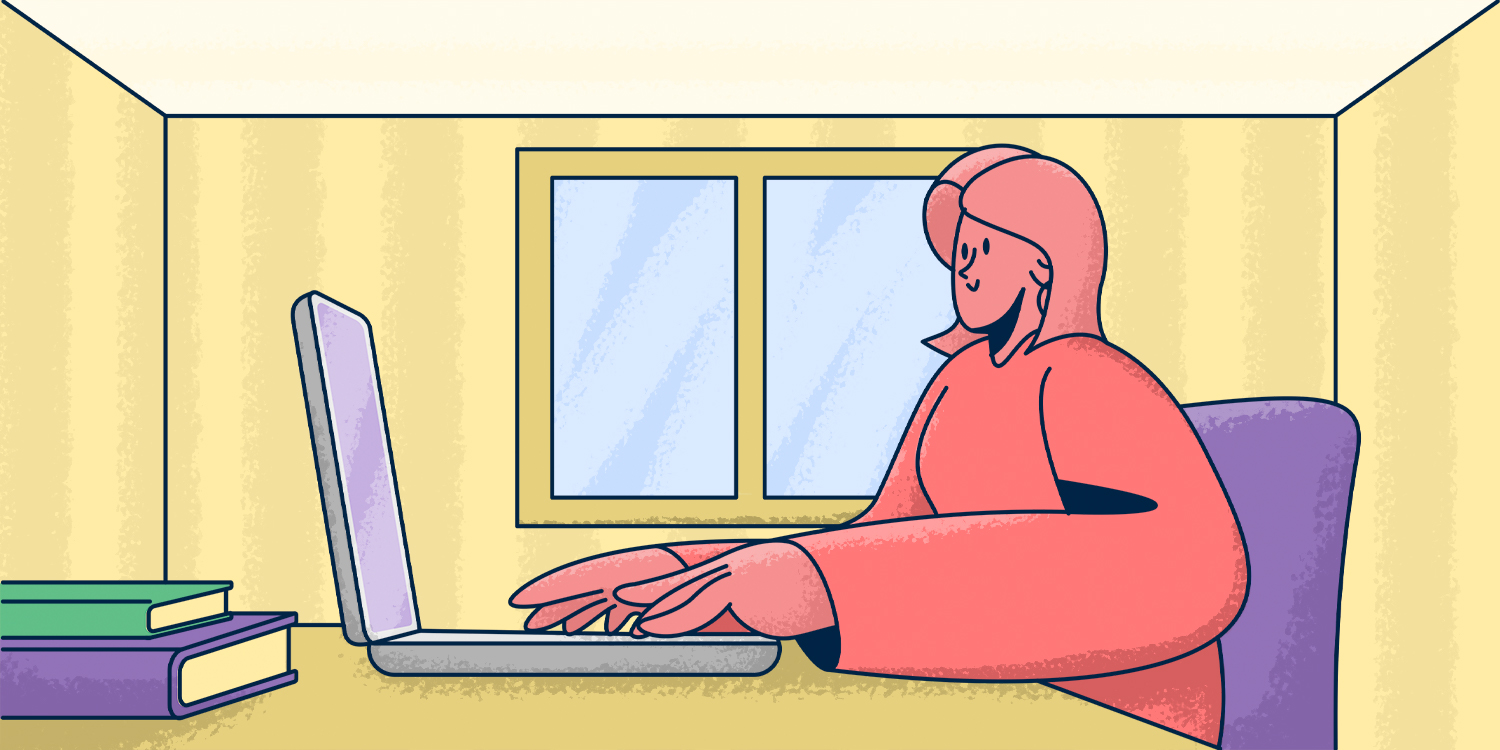
Follow-Up Email After The Interview: Examples And Templates
September 26 2024
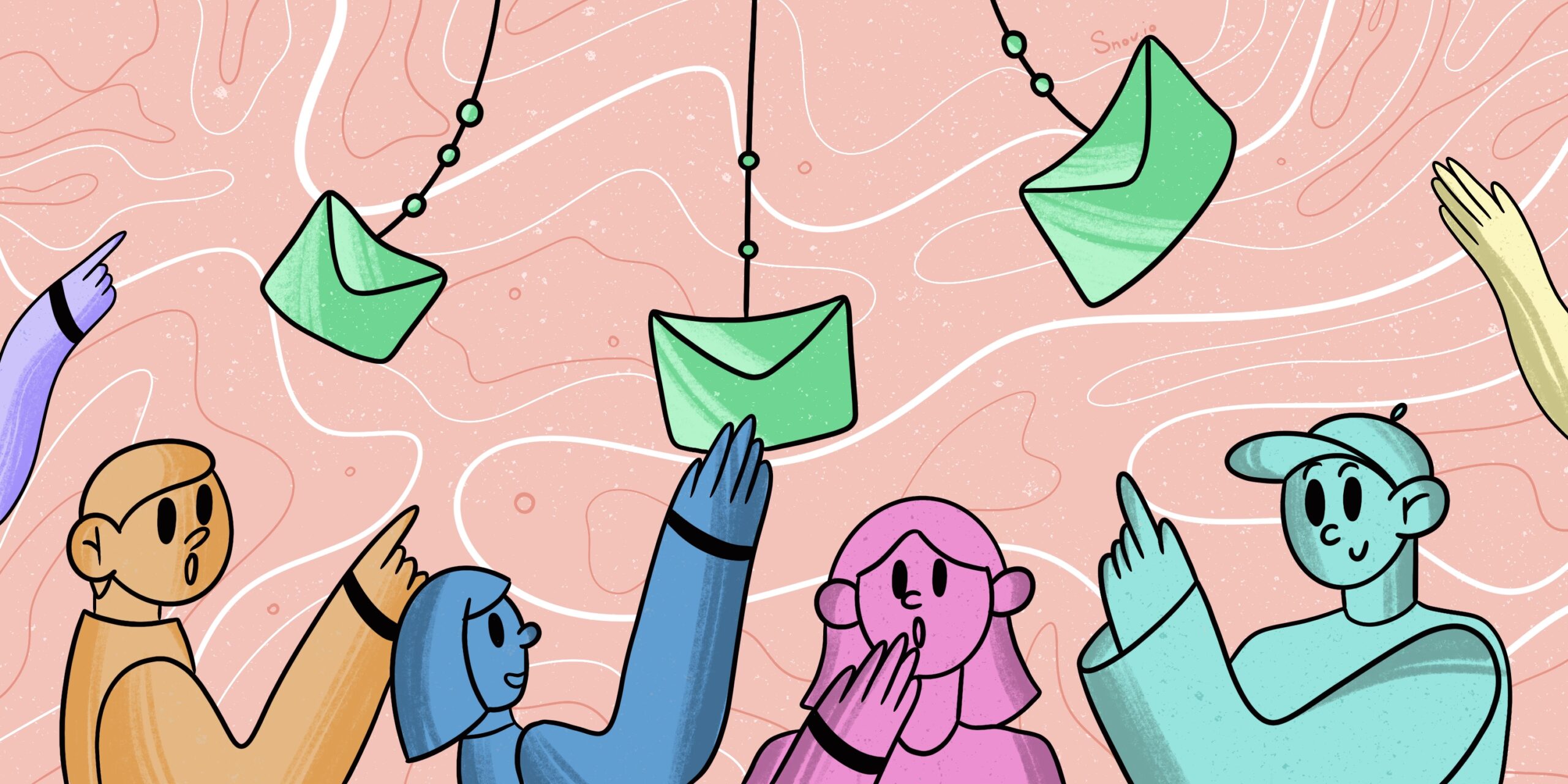
Free Follow-Up Email Templates For Any Purpose
September 26 2024
Improved sales email sequence
This email sequence can be a part of an after-sales email campaign when you aim to encourage your customer to repeat the purchase. As a rule, it boils down to upselling or cross-selling – the tactic well-known to E-commerce companies but also no stranger to the B2B SaaS landscape.
|
Upselling is offering your customers upgraded, more expensive products or services instead of what they initially wanted to buy or have already purchased. Cross-selling is offering customers additional goods or services relevant to what they’ve already purchased. |
You can start your improved sales sequence with a series of onboarding or educational emails (one of them is in the example below).

For example, start with an email congratulating the customer on their initial purchase, followed by a sequence that gradually educates them on the advantages of the product’s features, culminating in a tailored upsell offer that feels like the natural next step.

The improved sales sequence is just one aspect of a post-purchase campaign designed to boost customer retention. Other effective sequences include asking for feedback, requesting reviews, or encouraging testimonials. The latter, by the way, is the email sequence that we used at Snov.io ourselves. I’ll show you how it worked in the last chapter of this post.
Reminder email sequence
Reminder email sequences are typical of the event email campaigns where you invite a lead to participate in your webinar or conference and send them regular reminders so they won’t forget to show up.
Alternatively, you can use these sequences to remind your prospects about the already booked demo or meeting. Not to mix them with follow-up sequences, keep in mind that the goal of the reminder email sequences is to get a prospect to the event/meeting/call they’ve already agreed to participate in.

After the first reminder email, send another email within this sequence closer to the event date:

How to create an email sequence with Snov.io
Now that you understand the basics let’s talk about how you can easily create your own email sequence and how Snov.io can help you. Yes, Snov.io cold email tool might make you think it’s all about automating email drips, but you can successfully use it as one of email sequence tools.
Let’s break down the process into easy-to-follow steps.
Step 1. Determine the goal and email sequence type
Be strategic about the main purpose of your email sequencing. Are you aiming to bring a prospect to the sales demo? Or probably they’ve already agreed on it, and you want to ensure they’ll actually participate? By determining the goal, you will understand what type of email sequence you need to build.
In the first case, this will be a follow-up email sequence, and in the second – a reminder email sequence.
Step 2. Think of the number of emails for your sequence
You need to plan your email sequence ahead by evaluating your sales cycle and the number of emails it will comprise.
With the Snov.io drag-and-drop editor, you can add as many emails as necessary for your sequence:

|
How many emails should be in a sequence? Every marketing guru will tell you the same thing: there is no single optimal number of emails in a sequence. It all depends on your goals, industry, audience, sales cycle length, blah, blah, blah. From my experience, the common email sequence consists of 3 to 7 emails. It is considered enough to provide a prospect with valuable information, engage with them, and smoothly lead them to the desired action. |
Step 3. Define triggers
When configuring your email sequence, identify the conditions that need to be met for the automation to activate. In Snov.io, you can choose among three options: whether a recipient opened an email, clicked on a link, or booked a meeting via Calendly. Plus, you can also choose the waiting time for the trigger to come into action:

For example, if you’re creating a follow-up email sequence with the aim of drawing a prospect to the meeting, you’ll choose ‘Booked a meeting via Calendly.’

Step 4. Compose emails for the sequence
Now, it’s time to write the content for each email within your sequence. With Snov.io Email Drip Campaigns, you simply need to click the ‘Email’ element within the sequence you’ve created with the drag-and-drop editor.
You can craft emails yourself or take advantage of automation with the Snov.io AI Email Writer integrated into Email Drips. This tool automatically generates content based on the type and focus of the emails you select. The AI email assistant can also refine the copy to meet your needs.

Each email in your sequence will be personalized thanks to Snov.io’s email variables – pieces of text in email templates that are automatically filled with corresponding recipient data when the email is sent. Every prospect on your list (which you should collect or upload and segment in your Snov.io account beforehand) will get highly personalized messages tailored specifically to them.

Step 5. Choose the prospects
With Snov.io, after drafting your emails, you’ll select the prospect list to which your email sequence will be sent. You can set the details and filter the chosen list for precision targeting. For example, if you use Snov.io’s free CRM, you can automatically filter those who are ready to convert from those who are not interested.

Step 6. Set sending options
At this point, you’ll choose the email account from which your sequence will be sent, how the email automation tool will track it, and set the schedule and duration of the campaign.

Step 7. Review and test
Finally, review your email sequence settings and preview each email to see how it will appear to recipients. More so, Snov.io allows you to send test emails to ensure they display correctly on various devices and to verify that the personalization variables are working properly.

Enjoy! Your email sequence is now successfully built with minimal effort — Snov.io has automated nearly everything for you. 🙂
10 email sequence best practices
Now that you have a step-by-step guide for creating an email sequence and a tool that may assist you, I can’t help but offer some working recommendations that you can use as a personal checklist. 🙂
- Clearly define the goals of your email sequence. Be it lead nurturing, product onboarding, or sales conversion, having a specific objective will guide your content.
- Segment your audience. Use relevant criteria such as demographics, behavior, or engagement level to make your sequences targeted and personalized.
- Provide valuable and relevant content. Create emails that solve problems, answer questions, or address the pain points of your audience.
- Optimize email timing. Experiment to find the best times to send your emails, considering factors like time zones and content nature.
- Write converting subject lines. You need to ensure that each email within your sequence gets opened by recipients. For this, elaborate on a personalized subject line for every email that would resonate with users and tempt them to peep inside.
- Remember about a call to action. No matter which type of email sequence you’re sending, clearly define the desired action you want recipients to take in every email of the sequence – click a link, download content, book a meeting, or make a purchase. Ensure your CTA is prominent and compelling.
- Do A/B testing. Test various elements of your email, such as subject lines, content, and calls to action. Use the insights gained to refine and optimize your email sequences.
- Maintain consistency. Keep a uniform tone, branding, and messaging throughout your sequence to build trust and brand recognition.
- Optimize for mobile. About 1.7 billion users access emails on mobile devices, so your email design and content should be optimized for smaller screens.
- Monitor analytics. Regularly track key performance metrics, such as open rates, click-through rates, and conversion rates. Analyzing data helps you understand what’s working and what needs improvement.
How we used a winning email sequence to get testimonials from our customers: a case study from Snov.io
In the final chapter, I’d like to infuse a dose of inspiration into your email marketing endeavors by showing how we at Snov.io successfully used an email sequence to ask for testimonials from our loyal customers. The objective was to get positive responses from users who were willing to leave a testimonial (thereby making email replies our key metric).
Here’s what we did:
Step 1. Segmented our users
We have segmented all our paid customers by how long they’ve been with Snov.io to pick those users who regularly use credits and have been with Snov.io for more than a year.
Step 2. Created an email sequence
Within Snov.io Email Drip Campaigns, we built an email sequence consisting of an initial email followed by three follow-ups, each spaced out with different time delays. We also set a trigger to activate after the second follow-up; this trigger was based on whether a user opened an email:

Step 3. Elaborated on every email
We worked on each email within our sequence so that it was personalized and logically following the previous message. The last follow-up reinforced the messages that came before it.
Email 1
|
Hello first_name, This is my first time reaching out, so it is a great pleasure speaking to you. My name is Victoria, and I’m a Marketing Specialist here at Snov.io. I’m working on a series of share-all user testimonials. While going through a list of our most experienced and existing customers, I came across company_name and thought you’d be the perfect fit: you’ve been using Snov.io for Subscription and definitely have something to say about your experience. I would like to showcase your story and your accomplishments (and the small role Snov.io played in your results). I absolutely understand if you don’t have the time or desire to participate. But, if you’re undecided, here’s why it’s a great idea:
Here are the questions I’ll be asking for the testimonial:
We can get this testimonial published at the end of next month. Can I count you in?🙏 Looking forward to your reply, Viktoria Marketing Specialist from Snov.io |
Email 2
|
Hey first_name, how are you doing? Have you had the chance to look over my offer? This testimonial can help you get extra exposure and help us deliver a real experience review to other potential Snov.io users. Have a good day, Viktoria Marketing Specialist from Snov.io |
Email 3-4
|
Hey first_name, Hope you’ve had a chance to check out my Snov.io testimonial offer. I understand that you may be too busy or simply don’t see this offer as beneficial (fair enough), but if you are interested and just haven’t had the time to decide – let me know so I can tell you more about it. Here’s a quick overview of what I’m offering: – a dedicated page with a comprehensive testimonial about your experience with Snov.io tools You’ve been with us for Subscription, and your experience is extremely valuable both to us and to any potential Snov.io users. So, are you in?😉 Looking forward to your reply, Viktoria Marketing Specialist from Snov.io |
Step 4. Measured the performance of our email sequence
Upon sending emails, we tracked the email sequence performance to see how many replies we received. Each reply was carefully analyzed to determine whether the user accepted our request for a testimonial.


As a result, we got 17 replies, and to our delight, all were positive:)
Step 5. Contacted all converted users separately
Finally, we reached out individually to those users who agreed to share their experiences with Snov.io to collect their testimonials. You can now see some of them on our testimonials page.
→ Want to utilize social media to enhance your outreach? Choose a LinkedIn automation tool that fits your goals and get more leads!
Wrapping up
As you can see, making up your own automated email sequence is not as complicated as it may seem, provided you’ve got a plan, working examples, good email sequence software (of course), and some portion of friendly support.
You’ve got it all from Snov.io, so now it’s your turn to try how it works and share your impeccable results with us.
Happy email sequence sending:)
